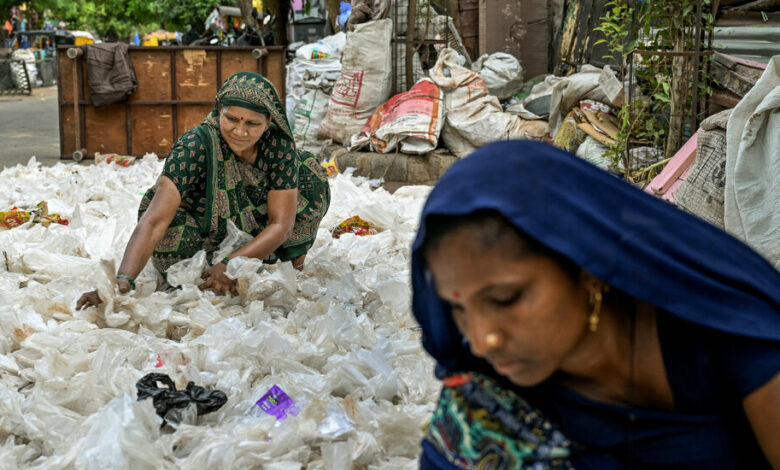Three ideas to beat the heat, and the people who made them happen

An app that helps people find relief from the heat.
A small insurance policy that pays working women when temperatures rise.
Local laws ensure that outdoor workers have access to water and shade on hot days.
With dangerous heat now impossible to ignore, practical innovations are emerging around the world to protect those most vulnerable to its dangers. What’s striking is that these efforts don’t require untested technologies. Instead, they’re based on ideas that are practical and already known to work.
They provide insight into the need to adapt to the new dangers of extreme heat that have become apparent in recent weeks. This continues to kill an unknown number of pilgrims, tourists and election workers worldwide, and has led to an increase in emergency room visits for heat-related illnesses in the United States.
The World Meteorological Organization has said heat is now killing more people than any other extreme weather hazard, and has called for many more people to be rescued. “Customized climate products and services” to protect people’s health, including easy-to-use tools to find help.
There’s an app for that
Iphigenia Keramitsoglou is an atmospheric physicist specializing in remote sensing data. She views the world from very far away.
However, much of her work is not remote at all. Dr. Keramitsoglou led a team that built a mobile app to give users real-time information on how to stay cool.
Enter your location into Extrema Global and it will show the outside temperature, air quality and colour-coded levels of heat risk. It will populate a map with places to cool off: parks, swimming pools, fountains and air-conditioned public buildings such as libraries. Tell the app where you want to go – for example from an apartment to a museum – and it offers three options: the fastest route, the coolest route and the coolest route with rest areas.
It is distilled from the mountains of useful data that Dr. Keramitsoglou, research director at the National Observatory in Athens, knew they existed but were not collected in one convenient place: weather data, maps of trees and locations of city swimming pools.
“What could be better than putting all this information in people’s hands?” she said recently in an interview, as warm winds blew through Athens, a harbinger of forest fires. “This was the motivation, to put things that I know exist into people’s hands so that this information can be useful and save lives.”
Greece has been on the front lines of heat and wildfires in recent years. This month, as temperatures soared above 100 degrees Fahrenheit (38 degrees Celsius), several tourists across the country reportedly died from heat-related causes. In Athens, authorities closed the Acropolis, a tourist attraction, as a precaution.
An early avatar of Extrema Global was launched in Athens in 2018. The app has since expanded to Paris, Milan and Rotterdam. Other cities have spawned similar apps. Melbourne has an app that does maps shaded routes for walkers and cyclists, and Barcelona has a mobile app for that maps the city’s fountains.
Small insurance policy, big effect
Hansa Ahir, a 55-year-old grandmother of two, goes to work before sunrise to prevent her city from drowning in its own waste.
A small insurance program is now saving her from drowning in debt.
Wading through piles of trash in the storied Indian city of Ahmedabad, Ms. Ahir collects everything that can be recycled — soda bottles, tomato cans, glass jars — then drags it home to have it cleaned, separated and sold. On average, she earns 200 rupees a day, about $2.40.
Since March, she said, the extreme heat has halved her income. By mid-morning it’s too hot to work. Her arms are red with the rash. There are no public taps to refill her water bottle. She’s been sick.
What has kept her going is a small new insurance program that acts as a safety net on days of dangerous heat, offered to her by the Self-Employed Women’s Association, an organization of 2.9 million women that Ms. Ahir joined 20 years ago has connected. The insurance policy cost her Rs 200 for one year of cover.
“I was very surprised. I had never heard of insurance that would cover my inability to work in the heat,” Ms. Ahir said by phone this week. “I thought, ‘Let’s give it a try. It’s just one day’s wages.’”
It wasn’t just an insurance product available. It was because it came through an organization she trusted.
The small insurance idea was pitched to the women’s association by an American climate finance expert, Kathy Baughman McLeod, who heads a non-profit organization called Climate Resilience for All. She raised $250,000 to cover premium costs. The women’s group started it as a pilot program in 2023. This year, 50,000 members signed up: market traders, subsistence farmers and waste recyclers like Ms Ahir.
For the women, Ms. Baughman McLeod said, it was “a leap of faith” to spend their money on this kind of completely new insurance. Many such leaps of faith are needed, she said, given the dangers. “We’re just learning how to deal with the heat. It’s a new reality that everyone is having to deal with.”
The program works like this: when temperatures are expected to reach dangerous levels, Ms. Ahir receives warning messages on her mobile phone. When temperatures reach that threshold, insurance payments are activated.
In May, when the city’s highs hit 104 degrees Fahrenheit, or 40 degrees Celsius, for three days in a row, Ms. Ahir received a payout of 400 rupees into her bank account. She used it to buy medicine and groceries. In June, when daily highs reached 115 degrees Fahrenheit, she received another 750 rupees. She used it to pay her rent.
A legal right to shade
Like many children of farm workers, Edgar Franks began helping his parents in the fields before he entered high school. There was the asparagus harvest in early summer in eastern Washington, then the strawberries in late summer in western Washington and back home to Texas for school in September.
The now 44-year-old Mr. Franks helps a new generation of farmworker families adapt to a new danger: extreme temperatures, sometimes mixed with the smoke of forest fires that hang thick over the fields.
Mr. Franks organized farm workers to pressure Washington state to implement new regulations to protect the health of farm workers. When temperatures reach 80 degrees Fahrenheit, farmworkers have the legal right to ask for shade, water and paid breaks.
Washington is one of five states in the country that rules for the protection of outdoor workers in situ. It contrasts with rollbacks of similar rules in Texas and Florida, where state laws now ban local ordinances that gave outdoor workers the right to mandatory water and rest breaks on extremely hot days.
Outdoor workers in agriculture and construction are among the International Labor Organization’s most vulnerable groups. 2.4 billion workers are at risk of heat hazards worldwide.
Washington’s heat protection rules first passed in 2008, but the old 89-degree Fahrenheit threshold wasn’t enough to protect outdoor workers. Farmworkers took to the streets outside the Labor Department offices. Several labor and community groups, including Familias Unidas por la Justicia, the union where Mr. Franks works, petitioned state officials.
The current emergency rules, with the lower threshold, were finalized in 2023. “People are still not familiar with the rules. It’s almost brand new,” said Tomas Ramon Vasquez, one of the founders of Familias Unidas.
Mr. Ramon, 39, is no stranger to the dangers of heat. High temperatures worsened a long drought in his hometown of Oaxaca, Mexico, more than two decades ago. His neighbors struggled to grow corn. Wells dried up. There was no other work nearby, so Mr. Ramon left, heading to California, then Oregon, then the berry fields of Washington.
Mr. Franks says summers have changed since his teenage years in the country. “It’s significantly worse. You really notice it,” he said. “You just feel the heat, even when it’s 80 degrees.”




